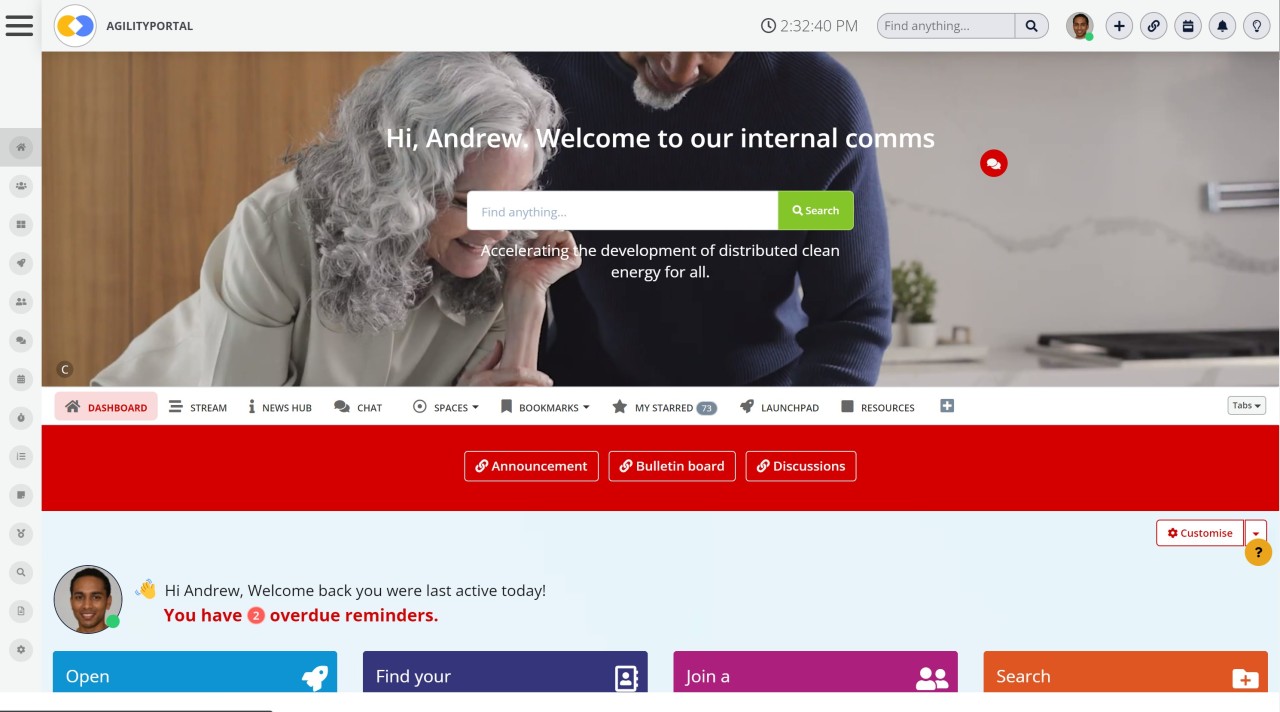Insight Blog
Agility’s perspectives on transforming the employee's experience throughout remote transformation using connected enterprise tools.
13 minutes reading time
(2652 words)
What is the best communication method for employees?
Effective employee engagement starts with effective communication. Discover the best communication methods to keep your employees engaged and motivated.
Over the past year, internal communications have played a crucial role in the workplace as the COVID-19 pandemic necessitated remote work for organizations that were traditionally office-based.
The companies that succeeded in adapting to this new normal were those that implemented flexible and innovative communication strategies, enabling them to maintain productivity while their team members worked from home during uncertain times.
Internal communication has proven to be so vital to productivity that nearly half (47%) of remote workers who felt less productive at home attributed their struggles to communication difficulties.
If you're seeking a solution to enhance internal communications for your dispersed workforce, whether it's due to remote work or the presence of non-office-based teams, a company intranet becomes an invaluable asset.
Modern intranets empower your internal communications strategies and team to instantly reach the entire workforce with essential updates, offering a fast and efficient means of ensuring crucial operational information reaches all team members.
An Intranet could possibly improve communication, so lets dig deeper into what is the best communication method for employees?
What is Effective Communication?
Effective communication is the process of conveying ideas, information, thoughts, knowledge, data, opinions, or messages from a sender to a receiver through a chosen method or channel with the purpose of ensuring clarity and understanding.
This process satisfies both the sender and the receiver and operates in a cyclic manner, starting and ending with the sender, who receives feedback or a response from the receiver.
Communication takes various forms, and information can be shared in different ways between individuals.
Communication takes various forms, and information can be shared in different ways between individuals.
These forms of communication include:
These communication methods can occur in person, over the phone, or through digital platforms.
- Verbal communication
- Non-verbal communication
- Written communication
- Visual communication
These communication methods can occur in person, over the phone, or through digital platforms.
The effectiveness of communication can have a significant impact on one's professional and personal life. Improved communication skills lead to greater proficiency in both work and personal aspects.
While precisely measuring the effectiveness of communication may be challenging, its impact can be observed in the workplace. A survey conducted in the USA and UK reported that nearly 100,000 employees collectively lost an average of $62.4 million in a year due to poor communication.
While precisely measuring the effectiveness of communication may be challenging, its impact can be observed in the workplace. A survey conducted in the USA and UK reported that nearly 100,000 employees collectively lost an average of $62.4 million in a year due to poor communication.
On the other hand, companies that prioritize effective communication experienced almost 50 percent higher total returns and increased stakeholder satisfaction.
Examples of effective communication include active listening, giving and receiving feedback, empathy and respectfulness, prompt response to messages, clear and concise expression, understanding non-verbal cues, fostering friendliness and confidence, and adapting communication style to suit the audience, among others.
Examples of effective communication include active listening, giving and receiving feedback, empathy and respectfulness, prompt response to messages, clear and concise expression, understanding non-verbal cues, fostering friendliness and confidence, and adapting communication style to suit the audience, among others.
Effective Communication In The Workplace
In the workplace, effective communication entails the clear exchange of information, thoughts, and ideas with others, promoting transparency and facilitating consensus among teams.
Following seven fundamental principles that ensure quality, effective communication enhances team productivity and cohesion, streamlining task completion for employees.
When interacting with colleagues, it is vital to maintain clarity and conciseness, staying focused on the topic at hand.
Additionally, offering context and background information is beneficial, especially when discussing unfamiliar subjects.
Lastly, it is crucial to refrain from personal attacks and gossip, as these can detrimentally impact team morale and overall productivity.
Types of Communication Method for Employees?
The best communication method for employees depends on various factors, including the organization's culture, the nature of the information being conveyed, the size of the workforce, and the preferences of the employees.
Here are some effective communication methods commonly used in workplaces:
- Face-to-Face Communication - In-person interactions allow for immediate feedback, clarity, and the opportunity to read non-verbal cues. This method is great for important discussions, sensitive matters, or team-building exercises.
- Email - Suitable for sharing detailed information, documents, and announcements. It provides a written record of communication and allows employees to respond at their convenience.
- Instant Messaging - Quick and informal communication for brief exchanges, questions, and updates. It's especially useful for remote teams and quick problem-solving.
- Team Collaboration Tools - Employee communication apps like Slack, Microsoft Teams, or similar tools offer real-time communication, file sharing, and integration with other apps, promoting efficient collaboration.
- Intranet or Company Portal - A centralized hub for important announcements, policies, and resources. It ensures all employees have access to crucial information.
- Video Conferencing - Enables face-to-face communication even for remote employees or teams in different locations, fostering a sense of connection.
- Town Hall Meetings - Periodic gatherings where leadership addresses the entire workforce, sharing updates, and allowing for Q&A sessions.
- Surveys and Feedback Mechanisms - Regularly seeking employee input through surveys or suggestion boxes can help gauge their concerns and satisfaction levels.
- Newsletters and Memos - Informative, engaging, and concise updates that can be distributed electronically or in print.
- Social Media or Internal Social Platforms - Utilizing platforms like LinkedIn, Yammer, or Workplace by Facebook for sharing updates, celebrating achievements, and promoting a sense of community.
Remember that a mix of these methods may be the most effective approach, as different situations call for different communication styles.
Additionally, seeking feedback from employees about their preferences can help tailor communication strategies to suit their needs and enhance overall employee engagement and satisfaction.
How to Build Effective Communication Practices?
- Set clear communication goals and objectives - Ensure that all team members comprehend the company's communication strategy and their individual roles within it. This clarity will keep them focused and enable them to fulfill their responsibilities more effectively.
- Prioritize communication - Making sure that everyone knows how to handle unexpected situations is essential for effective communication practices. Maintaining clarity during complex scenarios will benefit all involved, not just those requiring immediate information.
- Emphasize the value of listening - Dedicate time to attentively listen to others, even when you lack all the answers. This critical skill fosters understanding of their concerns and helps build strong relationships.
- Deliver effective communication feedback - Ensure that any feedback regarding communication is conveyed appropriately, enabling team members to take it to heart and enhance their communication skills in the future. Feedback should be constructive yet clear, promoting a learning environment while upholding mutual respect.
- Enhance your and your team's communication skills with Risely - Risely offers solutions to conquer ineffective communication and tackle over 30 other challenges associated with people management. Uncover your true potential today by signing up for Risely's free platform and taking charge of your personal and professional growth.
Follow us and access great exclusive content everyday: Follow us on Google News
How to improve your communication with employee in the workplace?
Improving communication with employees in the workplace is crucial for fostering a positive and productive environment.
Here are some tips to enhance your communication skills:
- Active Listening - Listen attentively to your employees when they speak. Avoid interrupting and show genuine interest in what they are saying. This encourages open dialogue and makes employees feel valued.
- Be Approachable - Create an atmosphere where employees feel comfortable approaching you with their concerns, questions, or suggestions. Maintain an open-door policy and be receptive to feedback.
- Clarify Expectations - Clearly communicate expectations, goals, and roles to your employees. Ensure they understand their responsibilities and what is expected of them.
- Use Clear and Simple Language - Avoid jargon or complex terms that might confuse employees. Use plain language to convey your messages effectively.
- Regular Team Meetings - Conduct regular team meetings to discuss progress, address challenges, and share important updates. Encourage open discussions during these sessions.
- Provide Constructive Feedback - When giving feedback, focus on specific behaviors or actions, and provide actionable suggestions for improvement. Be respectful and avoid personal attacks.
- Be Respectful and Empathetic - Treat your employees with respect and empathy. Understand their perspectives and challenges, and show appreciation for their efforts.
- Use Various Communication Channels - Use a mix of communication channels such as email, in-person meetings, instant messaging, or video conferencing, depending on the nature of the message and the preference of the employees.
- Be Transparent - Be open and honest with your employees about organizational changes, challenges, and successes. Transparency builds trust and credibility.
- Recognize and Celebrate Achievements - Acknowledge and celebrate individual and team achievements. Recognizing their efforts boosts morale and motivates employees.
- Foster a Feedback Culture - Encourage a culture of open feedback and encourage employees to provide their suggestions, ideas, and concerns.
- Active Body Language - Pay attention to your body language during conversations. Maintain eye contact, use gestures to emphasize points, and show enthusiasm or concern when appropriate.
- Respond Timely - Respond promptly to employee inquiries or concerns. This shows that you value their time and input.
- Adapt Your Style - Be adaptable in your communication style to accommodate different personalities and communication preferences among your employees.
- Communication Training - Consider offering communication training for yourself and your team. Effective communication is a skill that can be improved through learning and practice.
Remember, improving communication is an ongoing process. By actively working on these strategies, you can create a more open, transparent, and supportive workplace, leading to increased employee engagement and overall success for the organization.
What Tools can Help Improve Communication with Remove Workers?
Improving communication with remote workers requires the use of various tools and technologies that facilitate seamless and efficient interactions.
Here are some essential tools that can help enhance communication with remote workers:
- Video Conferencing Software - Tools like Zoom, Microsoft Teams, or Google Meet enable face-to-face communication through video calls. They are perfect for team meetings, one-on-one discussions, and virtual collaboration.2. **Instant Messaging Apps:** Applications like Slack, Microsoft Teams, or Discord allow real-time messaging and quick communication for quick questions, updates, and casual conversations.
- Project Management Platforms - Tools like Asana, Trello, or Monday.com help manage tasks, assign responsibilities, and track progress, promoting transparent communication on project status.
- Email and Cloud-Based Storage - Email is a standard means of communication. Cloud storage services like Google Drive or Dropbox make file sharing and collaboration easy.
- Virtual Whiteboards and Brainstorming Tools - Platforms like Miro or MURAL facilitate remote brainstorming, idea sharing, and visual collaboration.
- Screen Sharing Software - Tools like TeamViewer or AnyDesk allow screen sharing during virtual meetings, making it easier to present ideas and troubleshoot issues.
- Time Zone Converters - When working with remote workers across different time zones, tools like World Time Buddy or Timezone.io help schedule meetings that suit everyone's availability.
- Webinars and Webcasting Tools - For larger-scale presentations or training sessions, platforms like WebinarJam or GoToWebinar are useful.
- Internal Blogs or Intranets - Creating an internal blog or intranet can serve as a central hub for company updates, announcements, and knowledge sharing.
- Feedback and Survey Tools - Applications like SurveyMonkey or Typeform can gather feedback from remote employees, helping you understand their needs and concerns.
- Collaborative Document Editing - Google Workspace (formerly G Suite) or Microsoft Office 365 allows real-time collaboration on documents, spreadsheets, and presentations.
- Employee Engagement Platforms - Platforms like Officevibe or 15Five can help assess employee morale, gather feedback, and improve communication within the team.
- Task Automation Tools - Tools like Zapier or IFTTT can automate repetitive tasks and streamline workflows, freeing up time for more meaningful communication.
- Virtual Watercooler Platforms - Tools like Donut or Icebreaker facilitate random virtual coffee chats between remote employees, promoting social interactions and team bonding.
- Communication Guidelines and Training - Although not a specific tool, providing clear communication guidelines and training can help employees understand expectations and improve communication skills.
- Intranet software Like AgilityPortal is a valuable tool for improving communication and collaboration within an organization, especially for remote workers. An intranet is a private network that serves as a central hub for internal communication, information sharing, and collaboration.
When choosing tools, consider your team's specific needs, security requirements, and the compatibility of the tools with your existing systems.
A well-rounded set of communication tools can foster effective collaboration and ensure remote workers feel connected to the team and the organization.
You may also like: Best Apps for Employees: UPDATED 2022 – A Complete Guide
How to improve your internal communication using an intranet
Improving internal communication through an intranet can significantly enhance collaboration and information sharing within an organization.
Here are some key strategies to achieve this:
- Centralized Information Hub - Establish the intranet as a central repository for all important company information, policies, procedures, and announcements. This ensures that employees have easy access to the latest information.
- User-Friendly Interface - Design the intranet with a user-friendly interface to encourage employees to explore and use the platform. Intuitive navigation and a clean layout can make information retrieval seamless.
- Employee Profiles - Create detailed profiles for each employee on the intranet, including their roles, expertise, and contact information. This fosters better connections between colleagues and facilitates finding the right person for a particular task or project.
- Collaboration Tools - Incorporate collaboration tools such as discussion forums, chat features, and project management tools to encourage real-time communication and teamwork among employees.
- News and Updates - Utilize the intranet to regularly publish company news, updates, and achievements. Keeping everyone informed about the organization's progress fosters a sense of belonging and motivation.
- Employee Recognition - Implement a system on the intranet to recognize and appreciate employee accomplishments. This reinforces a positive work culture and boosts employee morale.
- Department-specific Pages - Create dedicated pages for each department, where they can share information relevant to their team's operations, goals, and achievements.
- Training and Development - Use the intranet to offer training resources, webinars, and educational materials to support employee development and continuous learning.
- Employee Surveys and Feedback - Conduct anonymous surveys or feedback forms through the intranet to gather insights from employees about their thoughts and suggestions. This helps to identify areas of improvement in communication and other aspects of the organization.
- Mobile Accessibility - Ensure that the intranet is mobile-friendly, allowing employees to access it from their smartphones or tablets. This enables easy communication even when employees are not at their desks.
- Multimedia Content - Incorporate multimedia elements such as videos, infographics, and images to make information engaging and easily understandable.
- Security and Privacy - Implement strong security measures to protect sensitive company information and ensure that employee data is safeguarded.
- Regular Updates - Regularly update the content on the intranet to keep it fresh and relevant, encouraging employees to visit the platform frequently.
By implementing these strategies, organizations can harness the full potential of their intranet to improve internal communication, foster a collaborative work environment, and enhance overall productivity.
How can AgilityPortal help you improve your Internal Communication
Intranets offer a diverse range of features that can significantly enhance internal communication within organizations—an enhancement that AgilityPortal can readily provide.
AgilityPortal stands as a comprehensive intranet solution, equipping teams and employees with powerful communication tools to foster better collaboration.
IT also serves as the foundational structure for organizations to elevate their internal communication to new heights.
The platform encompasses a chat system, a curated newsfeed for essential information dissemination among employees, and a member directory for streamlined connectivity.
In addition, AgilityPortal boasts numerous other intranet features that facilitate optimal team performance, such as an internal drive, project management tools, and collaborative capabilities.
It truly encompasses all the essential elements one desires in an intranet—and goes beyond expectations.
Curious to learn more about how AgilityPortal can usher your organization into the full spectrum of intranet advantages?
Free ebook: How To Get Your Intranet Off The Ground
Wrapping up
Effective communication plays a crucial role in every workplace, and it becomes even more important for managers to prioritize the art of listening over excessive speaking.
When managers actively listen to employee feedback and address their concerns, foster a supportive atmosphere, and cultivate trust while honing their own communication skills, they empower their teams to become more innovative and productive.
The practical examples of effective communication shared in the blog above will undoubtedly motivate and encourage you to communicate more effectively and foster a thriving work environment.
Categories
Blog
(2618)
Business Management
(320)
Employee Engagement
(210)
Digital Transformation
(174)
Growth
(119)
Intranets
(119)
Remote Work
(61)
Sales
(48)
Collaboration
(37)
Culture
(29)
Project management
(29)
Customer Experience
(26)
Knowledge Management
(21)
Leadership
(20)
Comparisons
(6)
News
(1)
Ready to learn more? 👍
One platform to optimize, manage and track all of your teams. Your new digital workplace is a click away. 🚀
Free for 14 days, no credit card required.















